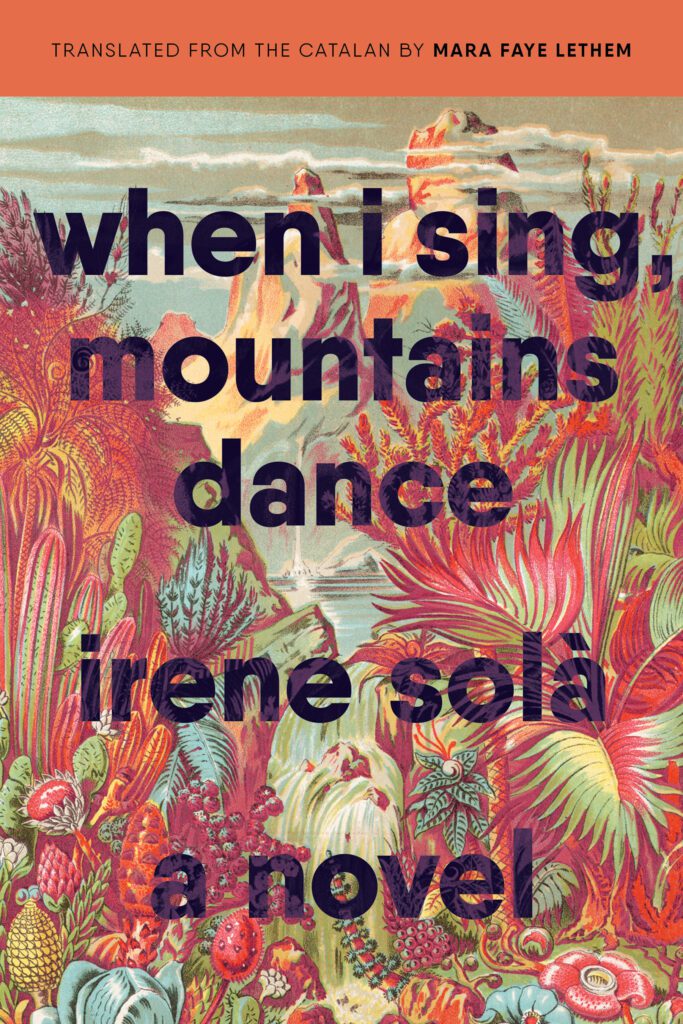In the age of the Anthropocene, Irene Solà’s When I Sing, Mountains Dance (216 pages; Graywolf Press; translated by Mara Faye Lethem) is a salve. Its texture is smooth yet it’s laced with herbaceous pungency. In a magically rendered translation from the Catalan by Mara Faye Lethem, Solà’s second novel offers up healing for those who care to find it. Set in the Pyrenees near Spain’s border with France, this marvelous book loosely traces one family’s tragedies and how they seep into the lives of others in their close-knit village. These troubles are refracted by the landscape, witnessed by unusual ghosts, and metabolized by nature.
From the opening paragraph, Solà plunges us into the choral perspective of an inexorable thunder storm. Reveling in “pour[ing] water out in colossal drops like coins onto the earth and the grass and the stones,” the storm releases a lightning bolt that finds the head of farmer-poet Domènec. He is killed instantly, to the fleeting interest of a ghostly coven of seventeenth century witches.
As Domènec lies dead the storm retreats, and the next chapter slides into the mind of Dolceta, one of the phantasmal women. With chatty amusement—Dolceta is always laughing, she tells us, even as she’s tortured for being a witch—she shares the names of her coven and their history of persecution. Only after Dolceta’s tale does Solà bring us to Sió, Domènec’s grieving widow, a city girl who struggles to raise the children she’s been left with on a mountainside of cows. From Sió, the book segues into the tangled eternal consciousness of the black chanterelle mushrooms living in the woods, some of which were in Domènec’s hand when he died.
This first section of When I Sing, Mountains Dance represents a microcosm of this innovative novel’s power to astonish.No perspective is repeated as the narrative moves forward in a diffuse yet linear fashion. Solà continues to weave in the non-human with tender skill, writing chapters in the voices of animals and even one in the grouchy timbre of the mountain range itself. These chapters could come across as gimmicky, but in Solà’s versatile hands they’re both playful and profound.
A shining star in the Catalan literary scene (When I Sing, Mountains Dance was originally published in Catalan in 2019 and won the European Union Prize for Literature in 2020), Solà is a visual artist and poet as well as a novelist. Her multifaceted skillset underlies everything in this lauded text, such as scraps of naif-wise poetry from a doomed boy or stunning images of the surroundings. In one of Solà’s cleverest moves, a city-dwelling outsider serves as the narrator for a chapter titled “The Setting.” This unnamed visitor is smug and entitled, yet offers the kind of rhapsodical view of the Pyrenees that a resident never would. In our tourist’s description of the shifting colors of the mountains, Solà’s visual artistry is evident:
You have to come up here in the fall, when the crest line turns from one color to another, now red, now chestnut brown, now the beige of a Pyrenean cow’s snout, now ochre, now orange, now deep garnet and colors you’ve never seen before in your life, with a sun yellow as an egg yolk.
The natural world’s prominence in When I Sing, Mountains Dance allows Solà to examine intergenerational trauma as part of the landscape of being human rather than as spectacle. Death, madness, and war all suffuse the environment in different ways, from specters both benevolent and foul to old ammunition from the Spanish Civil War that lies scattered around the forest. The remnants of this brutal conflict are treated as nigh-omnipresent in this world, in a deftly realistic way.
Against this backdrop, Solà lofts themes of embodied trauma and hereditary knowledge. A roe-buck learns from its mother “to run, to run far, if I get scared, to run, if I hear sounds, to run.” A neighbor discovers a malicious haunting in the house up the slope, thanks to the sight she inherited from her taciturn grandfather and water-finding mother. People who left in search of something greater are pulled back to where they came from, and ritualistic festivals welcoming spring continue year after year. Masculine silence and repression threaten, with Sió reflecting, “Some men’s tongues get stuck and just shrivel in their mouths, and they don’t know how to open up […] and that’s how family stories get lost.” By the end of the novel, nothing has been determined or solved, but something crucial has emerged: a sliver of hope that some cycles might be broken.
Despite its slim page count, When I Sing, Mountains Dance feels like an entire universe. It speaks of vastness even as it delves into the details of a recently harvested onion. With this imaginative triumph, Solà has created an enduring work that captures something of the quotidian expansiveness of time, nature, and life itself.

